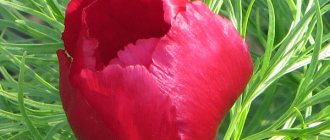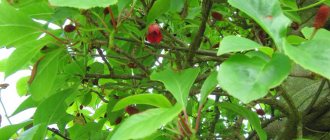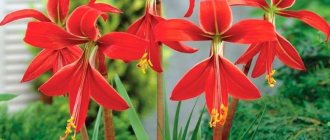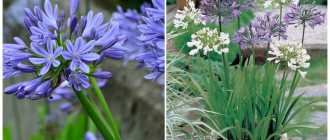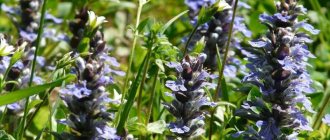The Coleus plant is a member of the Lamiaceae or Lamiaceae family. This genus includes approximately 150 species. Its name was derived from the word “kleos”, which is translated from Greek as “case”. In nature, species of such plants can be found in the tropical forests of Africa and Asia. Sometimes inexperienced gardeners call coleus the "poor man's croton" because its variegated foliage is similar to croton leaves, but it looks less impressive. This flower is also called a “garbage plant,” but this is done only by those gardeners who are unfamiliar with new varieties of coleus, which are highly decorative. They can compete with both croton and other popular decorative foliage plants. Besides the fact that coleus has spectacular foliage, it is very easy to care for.
Brief description of cultivation
- Bloom . Coleus is cultivated as an ornamental foliage plant.
- Landing . Seeds for seedlings are sown in the last days of March, and seedlings are planted in the soil in the second half of May.
- Illumination . Before noon, the flower needs a lot of bright sunlight, and then it needs a little shading.
- Temperature regime . In the summer - from 18 to 20 degrees, and in the winter months - no colder than 12 degrees.
- Watering . Moisten the soil frequently and abundantly.
- Air humidity . It needs high air humidity, so the bush should be frequently moistened with a spray bottle, especially on hot days.
- Fertilizer . During the spring-summer period, the flower is fed once every 7 days, and in winter - once every 4 weeks. For this purpose, a mineral complex fertilizer is used.
- Pinching . During the growing season it is carried out systematically.
- Trimming . The bush is pruned after the dormant period ends, at the very beginning of active growth.
- Rest period . In winter time.
- Transplant . Regularly once every 3 or 4 years.
- Reproduction . By cuttings and seed method.
- Pests insects . Aphids, whiteflies, mealybugs and spider mites.
- Diseases . Stem and root rot.
How to propagate coleus
Coleus propagation occurs in two ways:
- seeds;
- cuttings.
Planting cuttings is an opportunity to quickly obtain large, healthy plants.
- Cuttings are taken in late winter or early spring.
- They are planted in the ground or placed in water.
- Roots appear within 1-2 weeks.
- When the roots become stronger, the nettles are planted in peat pots.
- In order for the plant to grow, the tops should be pinched.
- Sprouts are planted in the ground at the dacha only when the temperature stays within +16 degrees during the day.
Seeds are sown in boxes with a nutrient container and sprinkled with sand, as described above.
- With proper care and temperature conditions (approximately +20 °C), seedlings can appear in 7-20 days.
- The sprouts are planted in peat pots, in a mixture of leaf soil, sand and turf, one part at a time.
- Water them regularly until they are planted in open ground.
Important! It is worth remembering that coleus grows quite rapidly.
Those plants that are sown with seeds turn into large and highly branched plants with large leaves after just 90 days.
If cuttings have been planted, the process occurs even faster. In order for the bush to grow not only in height, but also in width, you just need to pinch the tops of the shoots.
Features of Coleus
The tetrahedral ribbed shoots of coleus at the base become lignified. The opposite, heart-shaped leaf blades are pubescent and have a serrated edge. Some species have small leaves, but among them there are those whose foliage can reach a length of about 15 centimeters. In natural species, the foliage and shoots are very similar in appearance to nettles; therefore, the flower is also popularly called “nettle.” The color of the leaf blades is a different combination of burgundy, red, green and yellow. During flowering, a spike is formed, consisting of small flowers of lilac or blue color, but they do not represent any decorative value. Coleus is grown as an ornamental foliage plant, but among the various species and varieties of this plant there are also beautifully flowering ones.
How to grow coleus. Video channel Garden World
What causes coleus disease?
The most common flower pests are spider mites, whiteflies, and aphids.
Aphids suck the sap from the plant, after which the leaves turn yellow. It is recommended to use special pest control products.
Growing coleus in the garden
Sowing
Coleus is popular because it is very beautiful and also easy to care for. And also because homemade coleus can be grown in your garden plot in the warm season. This plant can be easily grown from seeds, and in specialized stores, if desired, you can find excellent Dutch or English variety mixtures.
It is recommended to sow seeds in the last days of March. You can sow seeds earlier or later, but in this case, during the cold season, the seedlings will require additional supplementary lighting. A low box that is filled with a light soil mixture rich in nutrients is ideal for sowing. Distribute the seeds evenly on the surface of the soil mixture and moisten the crops from the sprayer; there is no need to embed them in the substrate. Sprinkle the seeds on top with a thin layer of sand and cover the box with glass (film). Move the crops to a dark and warm place, making sure that the surface of the substrate in the box is slightly damp at all times. Good purchased seed material has a high germination rate; sometimes a sprout appears from each seed.
The first seedlings should appear just 1–1.5 weeks after sowing. As soon as this happens, remove the shelter and move the box to a well-lit place, protected from direct sunlight; a western or eastern window sill is perfect. The air temperature should be maintained at 17 to 19 degrees.
Coleus - growing from seeds
Growing seedlings
After the seedlings are 20–30 days old and have formed their first pair of true leaf blades, they will need to be picked into special cassettes. Thanks to this, the plants will be able to form a well-developed, powerful root system that will not be damaged during transplantation. Young bushes aged 5 to 6 weeks will require mandatory transplantation into individual 400 g glasses, after which they are pinched so that they grow bushier.
Transplanting
Seedlings can be planted in open soil only when warm weather sets in and return frosts are left behind. An area suitable for planting coleus should be sunny, but in the afternoon it should be slightly shaded. The flower also needs an area well protected from gusts of wind. Prepare the planting holes and fill them with a nutritious soil mixture that allows water and air to pass through well. Plant seedlings from cups in them.
Planting and growing coleus is relatively simple, especially if you cultivate it as an annual. If you decide to grow it as a perennial, then keep in mind that after 2 or 3 years the bush will lose its decorative effect, and you will have to grow young plants from cuttings or seeds. You should also remember that with the onset of autumn, the flowers will have to be dug up, planted in pots and brought into the house, and in spring they will be planted again in the garden.
Plant the seedlings on the prepared area, and the distance between them should not be very large. After this, they are watered abundantly.
GROWING Dwarf Coleus. COLEUS PICK!
Caring for coleus in the garden
In order for coleus to grow well in the garden, it must be watered abundantly, especially when there is a hot, dry period. For irrigation, it is recommended to use well-settled water, so you need to install a large tub or barrel in the garden plot; it can be used to accumulate rainwater or to settle tap water. When the flowers are watered, loosen the surface of the soil around them and pull out all the weeds.
In order for the bushes to grow more luxuriant, they should be lightly trimmed 2 or 3 times throughout the season. During the growing season, coleus growing in the garden should be systematically fed once every 7 days, using fertilizer with a high nitrogen content. Thanks to this, foliage will actively grow and develop, and flowering will be inhibited. As soon as the inflorescences begin to form, cut them off so that the coleus does not waste its energy on their growth and flowering. In this simple way you can grow a lush and spectacular coleus bush in the garden.
Description of the plant
Coleus is a genus of plants of the Yasotkov family. It includes perennial evergreen shrubs and herbs. In nature, these plants are found in Asia, Africa, Australia and Indonesia. Most species have bright decorative foliage. They are used to decorate the garden and are also grown as an indoor crop.
The coleus plant can reach 80 centimeters in height. A distinctive feature of many species is the very bright color of the leaf blade. It can be variegated, with white, green, pink, red stains, dots, veins, stripes. Color combinations vary. This can be clearly seen in the photos of coleus plants posted in our article.
It is for the brightness of the leaves that the plant is valued. However, it blooms unattractively. When grown in gardens and indoors, the peduncles are removed in order to show the beauty of the leaf blades.
Coleus at home
How to grow from seeds
Coleus can be grown not only in the garden, but also at home, and it can also be propagated either by cuttings or by seed. Such a flower is grown from seeds in the same way as seedlings for planting in open ground. However, after the seedlings are picked into separate cassettes, they are then transplanted into individual pots. Next, they begin to care for the bushes in the same way as adult plants.
Reproduction by cuttings
When pruning an adult bush, the remaining trimmings can not be thrown away, but used as cuttings. The length of the cutting should be approximately 10 centimeters; tear off all the leaf plates from its lower part. After this, it is planted in moistened sand or substrate for rooting; the segments must be covered with a cut plastic bottle or a transparent bag on top. Place them in a shaded area and keep them cool (18 to 20 degrees). Rooting takes 1–1.5 weeks, after which the cuttings that have given roots can be planted in a permanent place. It is very easy to propagate coleus this way.
Coleus care tips for formation, flowering, cuttings
Coleus care at home
To successfully grow indoor coleus, it is enough to provide it with the correct watering regime. To do this, it is regularly watered abundantly using soft, well-settled water, the temperature of which should be close to room temperature. Particular attention should be paid to watering in spring and summer. You need to feed homemade coleus, like garden coleus, once a week during the spring-summer period. To do this, use complex mineral fertilizer in half the dose recommended by the manufacturer. In the cold season, fertilizing is carried out once every 30 days.
In spring and summer, it is recommended to systematically moisten the bush with a spray bottle. However, it is impossible to moisten the foliage in direct sunlight. In winter, when the air in the room is dried out by operating heating devices, to increase its humidity level, moistened expanded clay is poured into the tray, and a pot with a plant is placed on it. Trim off the inflorescences that have begun to form in a timely manner; they are left only if an ornamental flowering species or variety is grown. During the growing season, the bushes will need to be pinched several times, in this case they will be more lush. After the dormant period ends, before the growing season begins, carry out anti-aging pruning; to do this, shorten all stems to 50–70 mm. Experienced gardeners recommend rooting several cuttings remaining after pruning. The fact is that last year's bush may lose its decorative effect.
Coleus propagation by cuttings
For propagation by cuttings, cut healthy shoots to 10-15 cm without inflorescences and buds. The lower leaf plates are removed. Place in clean water (preferably in dark glass), which is changed periodically. Sometimes root formation is stimulated by Heteroauxin and Kornevin. Keep the container with cuttings in a place without direct sunlight at a temperature of +18...+20 °C. When the roots hatch, they are planted in the ground.
In the second option, the cuttings are deepened into wet vermiculite. Sometimes they put them in a bag and cover them with a plastic bottle. After a week and a half, roots of 1-2 cm are formed, the shoots are planted in small cups. Sometimes covered with film. The coleus grows and is placed in open ground or in a pot with drainage. The first fertilizers are applied after 2-3 weeks.
Diseases and pests
If young coleus is not pinched or trimmed in a timely manner, its stems will become elongated. Also, a young bush can stretch out due to poor lighting, and this can also happen to an old flower. If the light is too intense, the foliage becomes faded and loses its color. If watered incorrectly, the bush begins to shed its leaves. This occurs both with excessively poor watering and due to stagnation of liquid in the root system.
Among the insects that can harm coleus are spider mites, aphids and whiteflies. Aphids suck the sap from the bush, which causes yellowing and shrinking of the affected leaf blades. This pest is also considered the main carrier of dangerous diseases. To destroy it, the home plant is sprayed with a soap solution. If necessary, the treatment is repeated after 7 days. Remember that when spraying a bush with a soap solution, the surface of the substrate in the pot must be protected with film. If aphids settle on garden bushes, they will have to be treated with a solution of a special insecticidal agent, for example, Fitoverma or Aktellika. In order to save coleus from spider mites, it is sprayed with Apollo, Akarin, Oberon or Agravertine. To combat whiteflies, they use the same means as to exterminate aphids: Aktara, Aktellik, Oberon and others.
The use of chemicals can greatly harm coleus, which is why it is so important to follow simple rules of prevention. It has long been known that healthy and strong plants are avoided by pests, so take care of the flower properly and provide it with suitable conditions for growth.
Pest and disease control
If the leaves of indoor coleus begin to suddenly lose color, most likely they are not getting enough sun. But there is also the opposite problem: unexpected white spots can turn out to be burns. This happens more often with young, vulnerable plants that are not yet accustomed to the daily routine.
Brown spots appear due to lack of moisture in the air, so do not forget about preventive spraying. Unexpected leaf fall is a sure indicator of nutritional deficiency. And if the flower begins to stretch too high, it needs preventive pinching and additional lighting.
Decorative coleus leaves are not very attractive to pests. But sometimes spider mites, whiteflies or aphids appear, so inspect the plants periodically. The affected flower must be urgently isolated from healthy ones and treated with insecticides.
Photo: greenhouse.cornell.edu
Dracaena (70 photos): types and features of care
Coleus in winter
Coleus is most often grown in the garden as an annual plant. However, if desired, a garden bush can be removed from the ground and planted in a pot, which is brought into the house. In this case, they care for it in the same way as for domestic coleus. With the onset of autumn, gradually reduce watering, while adding fertilizers to the soil mixture once every 30 days. The same care should be provided for homemade coleus. Also, during the winter months the flower should be kept cool (from 8 to 15 degrees).
There are 10+ varieties of coleus in winter!!! :) Where to place them??
Coleus transplant
This process occurs in the spring after pinching. The acidity of the prepared soil should be within 6-7 pH. However, it does not need to be moved repeatedly because its root system is poorly developed.
The plant is considered an annual, but if certain conditions are met, it can grow for more than one year, you just need to periodically change the soil, and if the pot becomes small, then replant it. In this case, it is necessary to carefully examine the roots for the presence of bad ones (rotten or dead), and, if possible, remove as much old soil as possible.
Types and varieties of coleus with photos and names
Hybrid coleus (Coleus x hybridus)
This species is most often cultivated at home. It is a small bush, distinguished by its unpretentiousness and low maintenance requirements. The bush can reach a height of about 100 cm, the cross-section of the shoots is square. The elongated oval leaf blades have a serrated edge. If the bush grows in a shaded place, then its leaves are green. If it is grown in a sunny place, then the color of the leaves will be burgundy.
Coleus rehneltianus
This species is native to Sri Lanka and is cultivated as an hanging plant. The stems can reach about half a meter in length. The long-petioled opposite leaf blades have a broad heart-shaped shape and a wavy edge. The foliage is decorated with veins that can be painted in various colors, for example: purple, red, yellow, brown, etc.
Coleus blumeii
This species is the most popular in culture, as well as its varieties, of which there are quite a few. This plant is native to Southeast Asia. This subshrub has stems reaching a height of up to 0.8 m, which at the base become lignified over time. Popular varieties:
- Black dragon . The violet-brown leaf blades, grooved along the edges, are decorated with red veins.
- Hybrids of the Vizzard series . Wizzard Gold has light-yellow foliage, Wizzard Evening Dawn - leaf blades of a fiery red hue have a narrow pale green border, Wizzard Jade - white leaves are decorated with a wide border of green.
BEAUTIFUL COLEUS! SUBTLES OF GROWING!
general description
Coleus is a representative of a group of evergreen shrubs and herbaceous annual plants with opposite foliage on the petioles. It is the foliage that is the most interesting in this plant; its leaves are variegated and original, with many colors and patterns.
The flowers are spike-shaped, collected in inflorescences from above. Most noticeable during single plantings. There are many types of plants, both annual and perennial, but nettle, which is grown in open ground, has some differences.
Coleus grows up to 80 cm in height. Its stem is powerful and becomes woody after six months. The leaves come in a variety of colors and may also differ in shape. On the leaves of some varieties, a border of various shades appears beautifully. Coleus flowers are similar to sage flowers, small and inconspicuous, blue in color.
Interesting! Indoor coleus was brought from the tropical countries of Asia a very long time ago. Although this plant is one of the representatives of the tropics, it is unpretentious and requires practically no special care.
Let's look at some simple rules for growing coleus in the garden .
Botanical description
Coleus stems are ribbed, tetrahedral, woody at the base. The leaves are pubescent, heart-shaped, opposite, jagged, sometimes small, but in some species they reach a length of 15 cm. The stems and leaves of natural plant species resemble nettles, which is why coleus is popularly nicknamed “nettle”. The color of the leaves is all possible combinations of green, burgundy, yellow, and red. Small blue or purple flowers are collected in spike-shaped inflorescences.
- Features of caring for the Decembrist
The flowering of decorative-leaved coleus does not cause any particular interest among gardeners - there is nothing remarkable in its flowers. These types of coleus are grown for their amazing leaves, although there are also beautifully flowering species and varieties of coleus.
Usage
In its homeland, the plant is used not only as a decorative garden decoration, but also grown for food. Some varieties of coleus have edible roots.
For example, on the island of Java, a variety of Blume with black tubers is grown, which are used for food. In Sudan, the Nigro variety is grown, which has dark, huge tubers. In Madagascar, a variety with small gray or yellowish-pink nodules is grown as a food product, and in Africa, coleus tubers reaching 20 cm in diameter are used as food.

